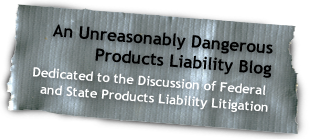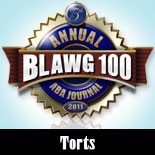Successor Liability Sinks Infomercial Tortfeasor
 It’s difficult coming up with award-winning content every week. Perhaps that’s why we here at Abnormal Use have not won any awards. Not to be deterred, contributors at the blog scour the web for news and decisions that could provide the kernel of inspiration to set us on our way to winning the blog equivalent of the EGOT. (“30 Rock” premieres on September 23, with a live episode on October 14.) Today, we tread into the sensitive subject of infomercial products.
It’s difficult coming up with award-winning content every week. Perhaps that’s why we here at Abnormal Use have not won any awards. Not to be deterred, contributors at the blog scour the web for news and decisions that could provide the kernel of inspiration to set us on our way to winning the blog equivalent of the EGOT. (“30 Rock” premieres on September 23, with a live episode on October 14.) Today, we tread into the sensitive subject of infomercial products.
“In December 2005, James Bishop purchased a Ronco rotissiere oven which was designed, manufactured, marketed, and distributed by Ronco Corporation.” Kentucky Farm Bureau Mut. Ins. Co. v. Ronco Acquisition Corp., No. 2009-CA-001979-MR, 2010 WL 3515808 (Ky. Ct. App. Sept. 10, 2010) [PDF]. Unfortunately for the Bishops, their home burned completely in December 2007, and, even more unfortunately for the Bishops, Farm Bureau pursued a claim against Ronco, asserting that the Ronco oven caused the fire. I’m sure it’s awful having your home burn to ashes. It’s worse when everyone knows that you can’t say no to an infomercial.
Ronco asserts that its oven gives you access to fresh “healthful food [that] has never been easier to prepare.” The webpage also presents testimonials from people who have lost 20+ pounds after buying the oven. Since being a lawyer prevents me from believing anything that I see or hear, let me posit an explanation for this advertising. Consumer A drops $160 + S&H on an oven, and probably more with the purchase of the optional “Rib Basket,” which is “Great for 3 or 4 people.” Upon receipt of the oven, Consumer A realizes that in purchasing the oven, he has spent his food budget for the next two weeks and will be unable to actually buy anything to cook in the oven. By not eating for the next two weeks, Consumer A loses 20 lbs, entirely due to the fact that he purchased the oven. Adding to the absurdity is the notion that the oven’s 3-hour automatic timer allows the consumer to “spend less time cooking and have more time for your active lifestyle.” I’m just guessing that someone who is willing to sit and watch an infomercial, rather than do anything else, to the point where he would order the product, is probably not concerned about an active lifestyle. None of his friends would say that he is at the pinnacle of fitness. He may, in fact, have the nickname, “Rib Basket.”
Fortunately for us, this case has legs. While it may be hard to believe that the original Ronco Corp. went bankrupt, the successor corporation, Ronco Acquisition Corporation, assumed (according to this court) its potential liability in this case via an Asset Purchase Agreement. The Kentucky Court of Appeals then reversed the lower court’s grant of summary judgment to Ronco, and remanded the case. Hopefully, we can bring you more as the facts of this case develop. Until then, you may want to stay away from the oven and try the Pocket Fisherman instead.














